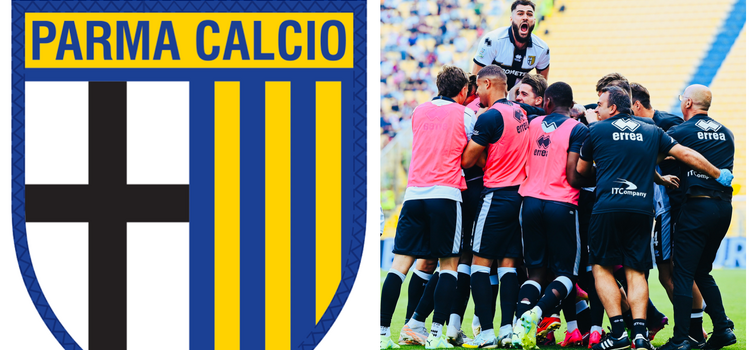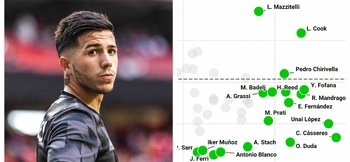Mathieu Lacome: How data analytics is powering Parma’s new era

Parma are in the Serie B play-offs
Written by SIMON AUSTIN — June 2, 2023
FOR a period in the 1990s, Parma were one of the best teams in Italy and indeed Europe.
Their sides featured stars like Gianfranco Zola, Faustino Asprilla, Juan Sebastian Veron and Lilian Thuram and they won the UEFA Cup in 1995 and 1999, as well as finishing runners-up in Serie A in 1997.
Those triumphs turned out to be built on quicksand though, because the club later went bankrupt and had to be re-founded all the way down in Serie D. Now under the ownership of American entrepreneur Kyle Krause, Parma are looking to rediscover past glories, although this time on more solid foundations.
New era
Krause has hired a number of senior staff to lead the project, including Mathieu Lacome. The Frenchman arrived from Paris Saint-Germain to take up the new role of Chief Performance and Analytics Officer in August 2021. He oversees a staff of 34, who cover game analysis, data analytics and performance.
Lacome tells TGG: “He (Krause) is not saying, ‘I want a five-year cycle and then to re-sell and make money.’ He wants to develop the club so he can be proud of what he has done 20 years from now.
“There are two main directions - he wants to develop young players in Parma and is also pushing a lot on the analytics side, because he believes we need to have more data-informed processes. It is an amazing project to be involved in.”
Of his own role, Lacome explains: “My remit is to make sure the department is working well and serving scouts, coaches and management and that every decision has data embedded in the process.”
When he arrived at Parma, in 2021, Lacome found there to be "no data nor analytics capabilities on the sporting side" of the club.
"Some data was collected, but always in siloes and rarely with quality checks," he explains.
Now, data and analytics services three main units - scouting, game analysis, and performance - "at a systematic stage or above."
"We want data to be embedded and evidenced within the day-to-day decision-making of the club,” Lacome adds.
Within this, a wide range of datasets, from different sources, are used. As well as bringing in a third party, Stats Perform, to capture Opta event data from all of Parma’s Academy games for their own private use, Lacome has championed the adoption of a brand-new dataset to further optimise their data processes.
This is called Opta Vision and is a set of advanced performance metrics comprising outputs trained on a combination of player event data and tracking data. These are available for 40 different competitions around the world, including several leagues outside Italy that are currently monitored by Parma’s scouting operation.
In a previous article, Stats Perform’s Jonny Whitmore explained how these new metrics, which are predictive rather than simply descriptive, are transforming the way we look at both football data and at the game itself.
“Getting access to Opta Vision and these more advanced metrics is very good for us, so we can combine tracking and events and get more granular information," Lacome says. “We are moving from descriptive to more predictive analytics, so we are very happy with this.”
There are three main use-cases of these new data resources in use at Parma at the moment:
1. Player and coach recruitment
Using data to clearly define how you want to play, before recruiting staff and players to fit this model, is key, although we frequently see clubs failing to do this.
“This is where you end up buying players who, six months later, do not fit the way the coach wants to play and you lose money,” says Lacome.
“It is very important to have a vision for where you want to go as a club, how you want to play. You don’t need to go into very deep tactical concepts, but you need to have a vision for how you want to play.
“Then, when you look at bringing in players and coaches, you need to make sure they are aligned with the system. We have a strong vision of how we want to play and are still working on iterating this.

"The data can highlight the players that the scouts might not have thought about" Mathieu Lacome
“We are a team that want to use counter pressing. Depending on who we are playing, we use a high pressing style or mid block and we like to use our young and fast wingers as much as we can on the transition.
“We are also one of the teams that possess the ball the most in Serie B.”
Opta Vision metrics give Parma “a better understanding of playing style and more granular information about on and off-the-ball actions.”
These include detail on “decision-making under pressure, creating space, moving between the lines to link passes”, which is “a lot deeper than traditional event data like number of crosses, number of balls into the box and even expected goals.”
The Performance and Analytics department has a database of about 40,000 players and is able to compare them based on pre-defined KPIs and to review their injury history and contract terms.
Using machine learning models, they are also developing other specific metrics such as danger creation, defensive capabilities and scoring abilities.

Parma in front of their own fans, with their legendary keeper Gianluigi Buffon centre
Using Opta Vision, Parma will also have Serie B fitness data from next season, "which will help us to compare ourselves with other teams and to understand trends in the league and in other leagues."
There has been a big debate in football about the balance between data and human eyes in scouting, with many clubs moving more towards the former than the latter.
Despite his data focus, Lacome data has to act as a support and check for human scouting - and vice versa.
"I really believe in bringing the two together and don’t think you can have a very sustainable model just going purely data," he says.
“The data can highlight the players that the scouts might not have thought about - because they were from an under-scrutinised market, or playing for a under-performing team - but we want to make sure the data is good, normalised and the players are then screened by the scouts.
“They can go deeper, find out about the player environment, do a visual check, understand better the situation before we move them forward in our recruitment process.”
2. Aligning Academy and first team
The youth set-up is fundamental to Krause’s vision for Parma. He has said: “We must develop talents from the Academy who can be ready to perform in Serie A within the next 10 years. We need to give them the feeling they can grow with us.”
This seems to be working out well, because Parma had one of the youngest average starting line-ups in Serie B this season.
Last summer they hired Mattia Notari from Juventus (where he was Under-20s Scouting Co-Ordinator) to become their Head of Youth. Data analytics is again important in making sure that the Academy is aligned with the senior side in terms of the playing style and philosophy.
This has been the main driver in getting Opta data collected from Parma’s age group matches.
“We have a philosophy of how we want to play and are working on bringing this into the youth set-up, so we can work on the players who will fit into this vision three or four years from now,” Lacome explains.
“The end goal is to produce players who will play for our first team. We are making sure we are following the youth, getting good access to their data, so we can work with them.
“From the U16s up to the first team all the games are tagged by Opta, so we have the same data provider all the way to the first team. This means we can look at it through the same lens and see the in-game performance of the players through the pathway and if it fits what the first team is doing.”
3. Talent development
The third use case of the Opta datasets is in talent development, of both senior and Academy players.?
Lacome explains: “Using a mix of game analysis, data and performance support, we are able to review the players’ progress every eight to 10 weeks. We are then able to produce dedicated action plans and individualised training for them.
“Every eight weeks we can have quantitative and qualitative analysis of the players and discuss with the coach what we want to do and adapt the individual development plan of the player as well.
“Leveraging Opta data has also been easing the work of the analysts. We can transfer Opta data in XMLs so the analysts have the game pre-tagged. We just add some custom tags that reflect the way we want to play.”
- For further information on Opta Vision, CLICK HERE





-1.png)





